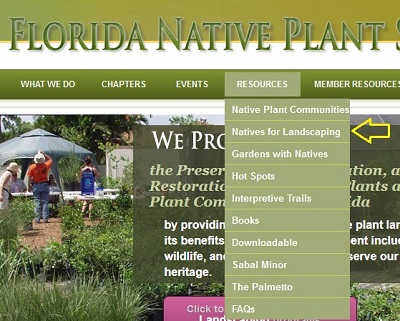Natives for Landscaping: an FNPS Tool for You
 |
| From the homepage of www.fnps.org, use the drop down menu under "Resources" and choose "Natives for Landscaping." |
The FNPS Website
We are fortunate to have a website with so many useful resources, not just FNPS business like finding a chapter, having a calendar of activities, and FNPS news, but also a description of Florida's various plant communities, Florida gardens with natives, and the tool we're covering in this post, Natives for Landscaping.You can reach this tool by using the drop down menu under "Resources" or you can type its URL: www.fnps.org/plants. You have the option to create a list of natives to fit your requirements or you can find more information about a single plant.
Create a List of Natives
If you are looking for a range of suggestions to suit your landscaping needs, then place your cursor on your county on the map, then click. |
| You choose your county with your mouse.I choose Clay County |
 |
| After choosing a county, then select the characteristics of the place you'd like to plant. Remember the more restrictions on the site the smaller your list will be. |
 |
| If you know what plant you're looking for, use this search tool. |
Find a Specific Plant
If you're looking for more details about a certain native, use this search tool on the Left of the main page of this resource.Type in a few letters of either the scientific or common name. You may find that after a few letters some choices are offered. You can choose one of those plants, but if the plant you're looking for is not on that list just type a few more letters and click the "Go" button.
 |
| After I typed in "beauty," I was give these three species and the option for a new search. |
For this example I typed in "beauty" to find information on beautyberry. These three plants were offered.
The orange ball indicates a plant that is likely to be found in native nurseries. Click the scientific name to go to the plant's page.
If the plant you're looking for is not offered, don't give up, maybe there is a different common name, so see if you can find the genus of the scientific name. to type. Or you could create a list of options by clicking the "Pick by Location and Need" button.
 |
 |
| The beautyberry page provides the scientific name, the family and several photos. |
The beautyberry page includes the USDA plant zones that beautyberry can grow in successfully. |
Each plant has at least one photo, but most have several photos. Click to see the larger version of each photo to help you with the details.
 |
 |
| Size estimates and more plant information. It's important to plant for the mature sizes of the plants. |
It lists landscape recommendations and the conditions where it does the best. |
 |
 |
| When choosing plants for habitat, it's important to know the wildlife values. |
For many of the landscape favorites, there is a direct link to www.PlantRealFlorida.com for a list of nurseries that may have it in stock. The lists are provided by the nurseries and vary with time. |
Reminder
When you are adding natives to your landscape there are several things you need to keep in mind.1) Plant for the mature sizes of your natives: leave enough space between the plants and other structures so they can grow naturally. Don't plant for curb appeal today, but for the long-term. If the spaces between the small plants bother you, fill in with short-term plants like bunching grasses or other herbaceous plants.
2) Use the best planting techniques and irrigate liberally until established.
For more information on this see my post: Native Plants for Your Yard: the Next Step.
I hope you've enjoyed this tour of an extremely useful resource presented by your Florida Native Plant Society. Please support FNPS both with your dollars and by actively participating in activities on both a chapter and state levels. Thanks to Shirley Denton and her website committee for all the hard work to keep this resource up to date.
Posted by Ginny Stibolt





Comments